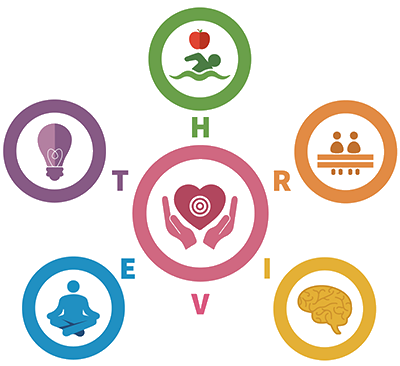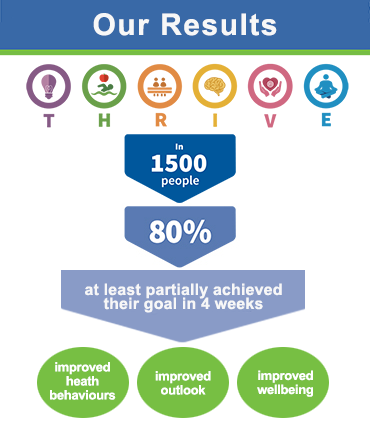The THRIVE© Approach to Wellbeing
In the THRIVE © Approach to Wellbeing, apply 3 key steps to help you to meet goals to help you thrive.
To “thrive” means to progress toward a goal despite or because of circumstances. (Mirriam Webster’s Dictionary). In the THRIVE © Approach to Wellbeing, THRIVE is also an acronym for the key domains known to promote wellbeing.
Learn more below!
3 Steps of the THRIVE © Approach to Wellbeing:
STEP 1: Self-assess to get a baseline. Reflect on how you would rate yourself across the THRIVE domains.
(link is external)Take the THRIVE Quiz ![]()
STEP 2: Set your goal. Identify one goal in one of the THRIVE action areas. Make it a SMART goal to increase success.
SMART goal resource
STEP 3: Track your progress. Use a method to monitor your progress - we recommend using
(link is external)The Wellness App
our free, web-based support tool usable on any device

The THRIVE © Approach to Wellbeing includes six high impact actions known to promote wellbeing:
Does the THRIVE © Approach to Wellbeing work?
The THRIVE © Approach to Wellbeing is based on ten years of implementation of the Fountain of Health tools in frontline care and in community settings.
The Thrive © Approach is grounded in the principles of Cognitive Behaviour Therapy and Behaviour Activation. Cognitive Therapy highlights links among our cognitions (thoughts), behaviours (actions) and mood (feelings). Behaviour activation helps you set goals that you can meet (actions).
These are powerful, evidence-based interventions used to treat many disorders including anxiety, depression, obesity, diabetes and heart disease. These approaches can also be used effectively to promote your wellbeing and happiness.

The Science behind the THRIVE © Approach to Wellbeing:
Happiness and Wellbeing Science
The THRIVE © Approach to Wellbeing utilizes Positive Psychology’s happiness science and the PERMATM Model of Wellbeing: Positive emotion, Engagement, positive Relationships, Meaning and Accomplishments. The THRIVE © Approach includes and expands on these areas, with two additional domains: Thoughts (Positive Thinking) and Health habits (Physical Activity and Healthy Eating). As well as promoting positive emotions, the THRIVE domain of Emotions includes management of negative emotional states, consistent with “positive psychiatry”. Importantly, the THRIVE domain of Valued Goals also offers an effective methodology to put wellbeing science into action. “SMART” goal-setting supports behavioural activation to set goals with Meaning that can be Accomplished.
Resilience Science
The THRIVE © Approach to Wellbeing includes key learnings from research on resilience, or the capacity to overcome adversity, and to navigate resources that sustain wellbeing when faced with significant adversity. Domains of the THRIVE © Model of Wellbeing include key actions that have been shown to promote resilience, and sustain wellbeing in the face of adversity. For example, trusted Relationships is the single best predictor of wellbeing. across the lifespan.
Active Coping Science
The THRIVE © Approach to Wellbeing integrates the science of active coping or adaptive responses to serious life stresses. The framework for active coping from the stress of serious illness was recently updated to address the stress of the COVID-19 pandemic. The THRIVE domains encompass all three categories of active coping: Problem-focussed coping (Health Habits and Interests; Emotion-based coping (Relationships and Emotions) and 3. Meaning-based coping (Thoughts and Valued Goals).
Lifestyle Medicine and Longevity Science
Preventative and lifestyle medicine shows that 85% of chronic diseases are caused by unhealthy lifestyles . The THRIVE ©Approach to Wellbeing includes six pillars from lifestyle medicine: Social Activity (Relationships); Physical Activity and Nutrition (Health Habits); and Managing Stress, Improving Sleep and Avoiding substances (Emotions). The THRIVE © Approach to Wellbeing also added the domain of Thoughts (Positive Thinking) since longevity research shows those with positive self-perceptions of aging outlive those with negative views by 7.5 years!
Research also shows physicians who use preventative medicine strategies themselves are more likely to use them in practice. Physicians are invited to enroll in our Thrive MD Program, and all registered clinicians can enroll in our 5-minute CBT Course through the Thrive Learning Centre to learn how to apply the approach to themselves, and in practice.
Brain Neuroplasticity Science
Neuroplasticity is the ability of our brains to change and “rewire” in response to activities, at any age. Our daily activities and habits can change and rewire our brains. The key THRIVE domains serve to optimize brain neuroplasticity and protect the brain from negative effects of stress. Science shows that shifting our thoughts and lifestyle habits in key areas will promote our brain’s capacity to regulate emotions under stress and help us to thrive in the face of adversity.
Behaviour Change Science
The THRIVE © Approach to Wellbeing is grounded in the principles of Cognitive Behaviour Therapy(link is external) and Behaviour Activation, which are powerful, evidence-based interventions used to treat many disorders that can also promote happiness and wellbeing. Everyone is invited to register to use The Wellness App and apply our 3-step approach. All regulated health care providers are invited to download our Health Behaviour Change Toolkit for use in frontline care, and take the 5- Minute CBT course.
Who developed the THRIVE © Approach to Wellbeing?
The THRIVE © Approach to Wellbeing was developed by our expert team led by Dr. Keri-Leigh Cassidy in collaboration with other international experts, with contributions by our Thrive MD instructors.
Our team also includes international experts Dr. Michael Vallis, behavioural psychologist, founder of the Behaviour Change Institute at Dalhousie University; Dr. Erica Frank, Canada’s Research Chair in Preventative Medicine; and Dr. Dilip Jeste, founder of Positive Psychiatry. See Our People
How it Works:
Additional Resources:
The Science of Brain Neuroplasticity:
Growing Evidence of Brain Plasticity
TEDx on Neuroplasticity
Wellbeing Science:
Positive Psychology
PERMA Model
Resilience:
The 3 Secrets of Resilient People
(link is external)Self-Compassion Skills and Resources
Preventative Health:
Why Lifestyle is the Best Medicine
The Association between Physicians’ and Patients’ Preventative Health Practices
Lifestyle Medicine
Behaviour Change Science:
Feeling Good
Introduction to CBT
Active Coping:
3 Steps to Coping with Anything (even COVID-19)
Links to THRIVE Actions














